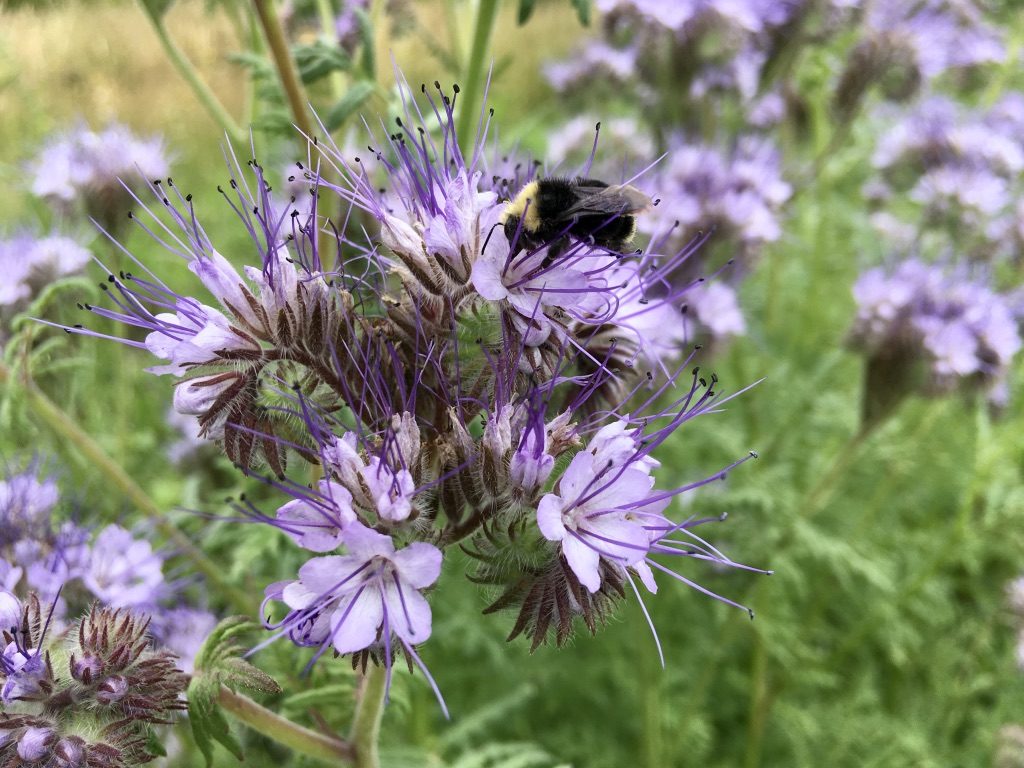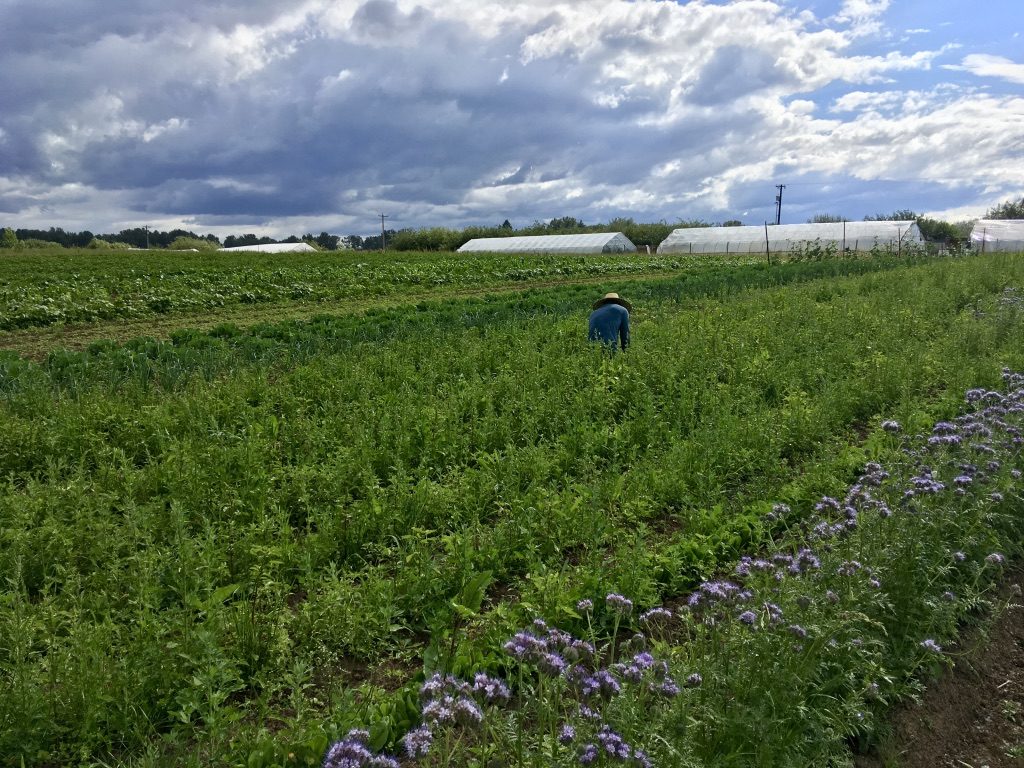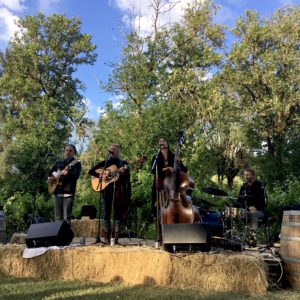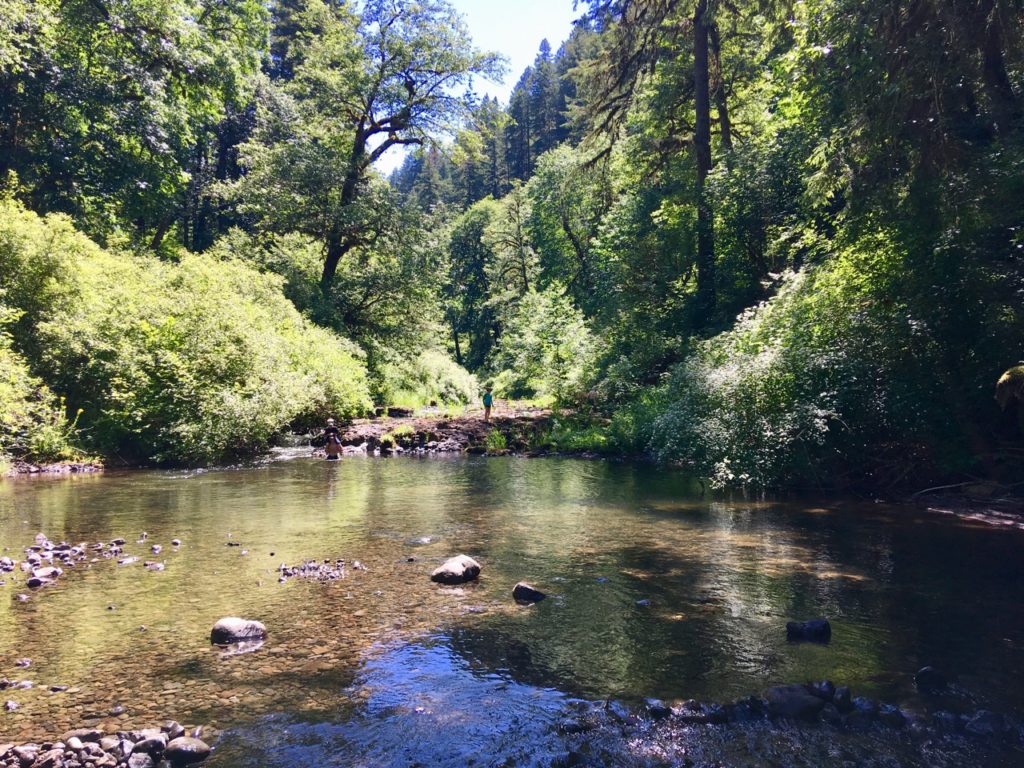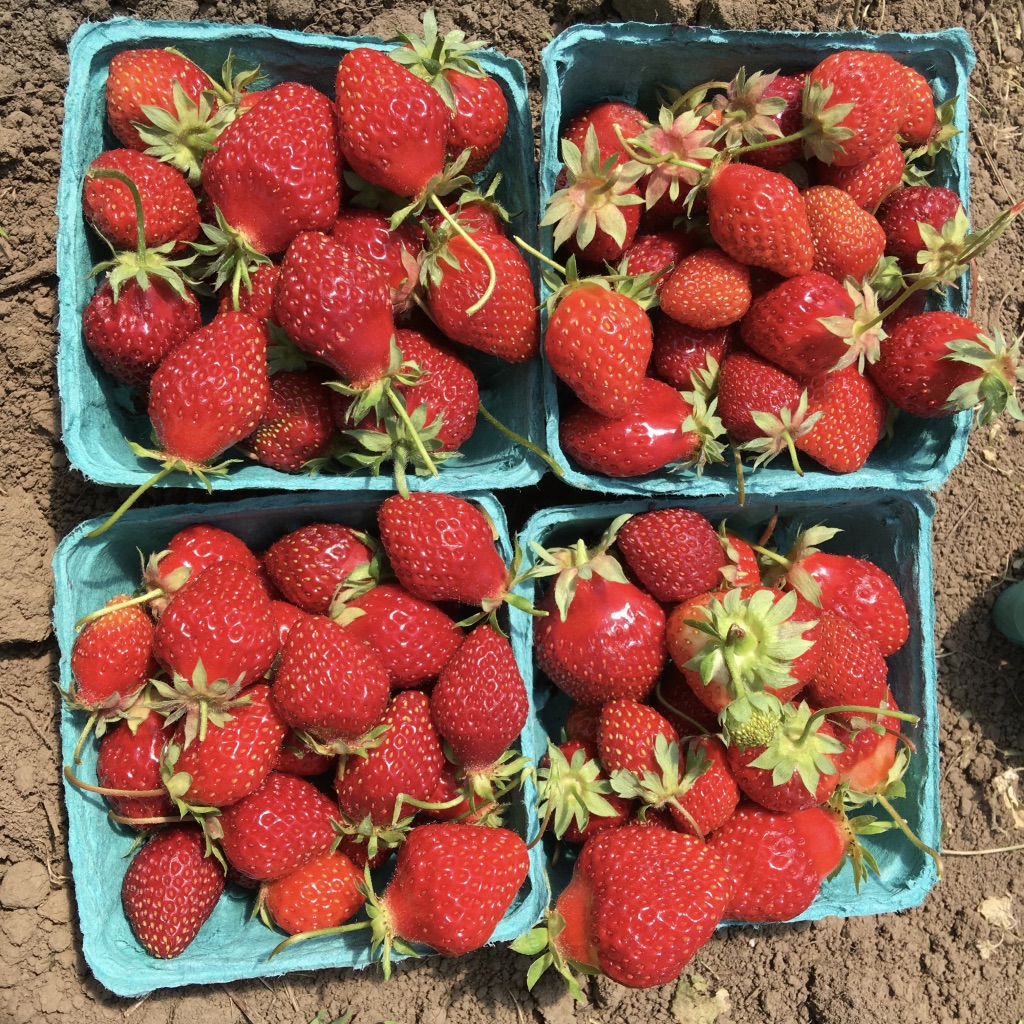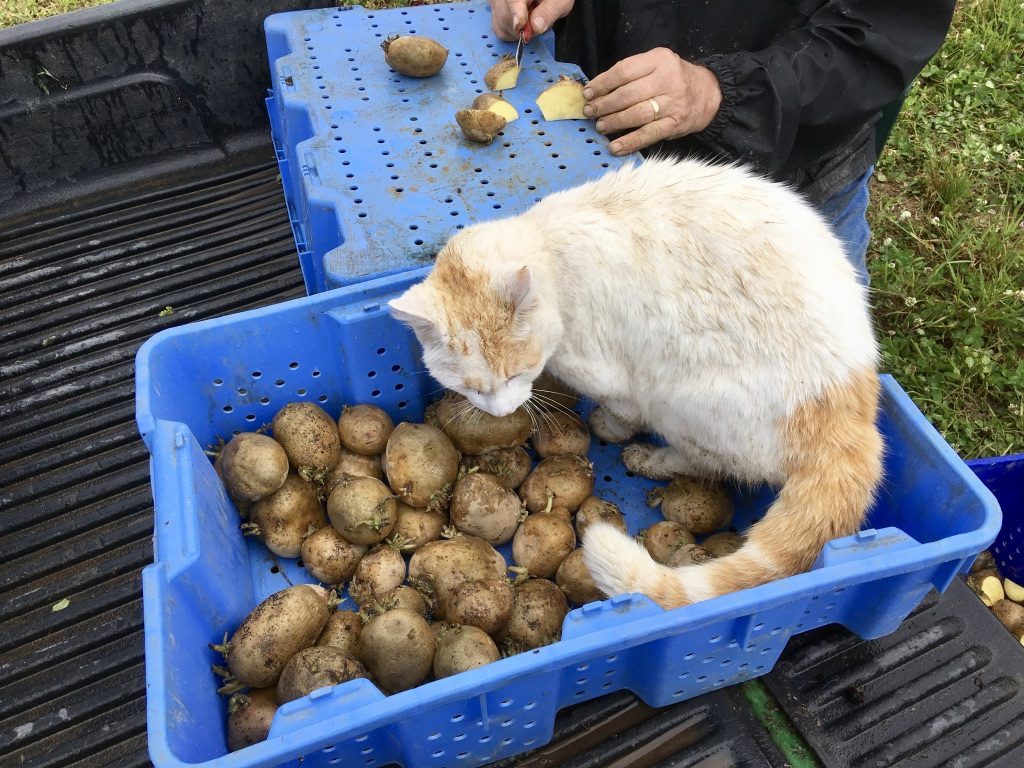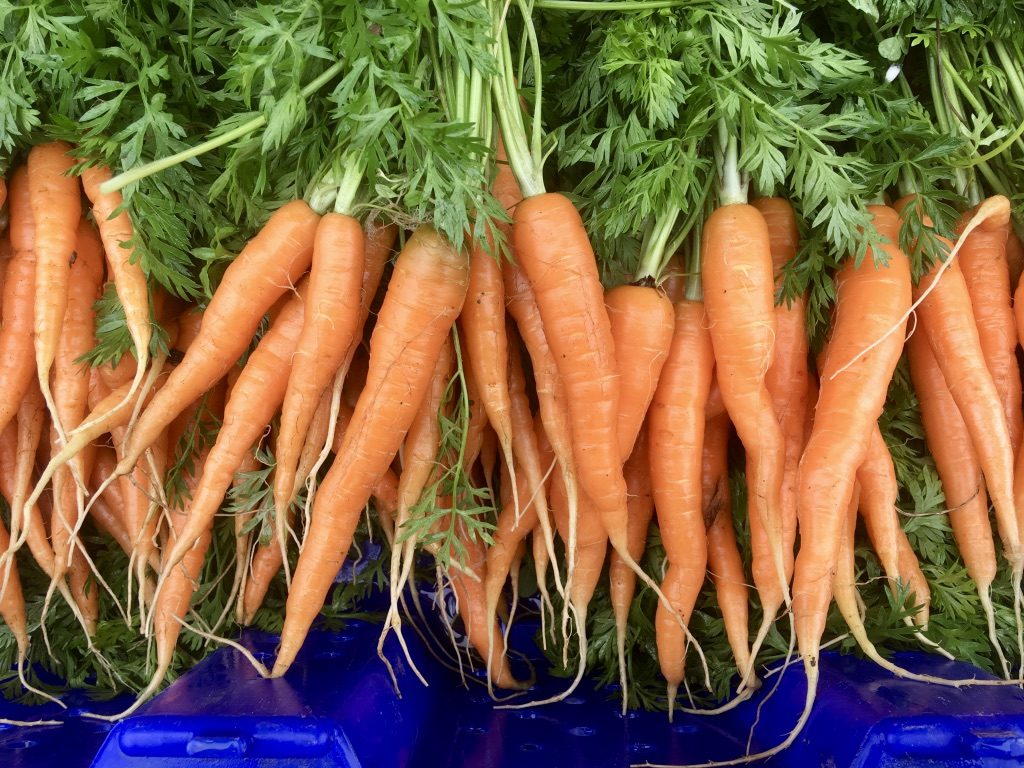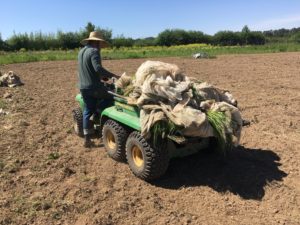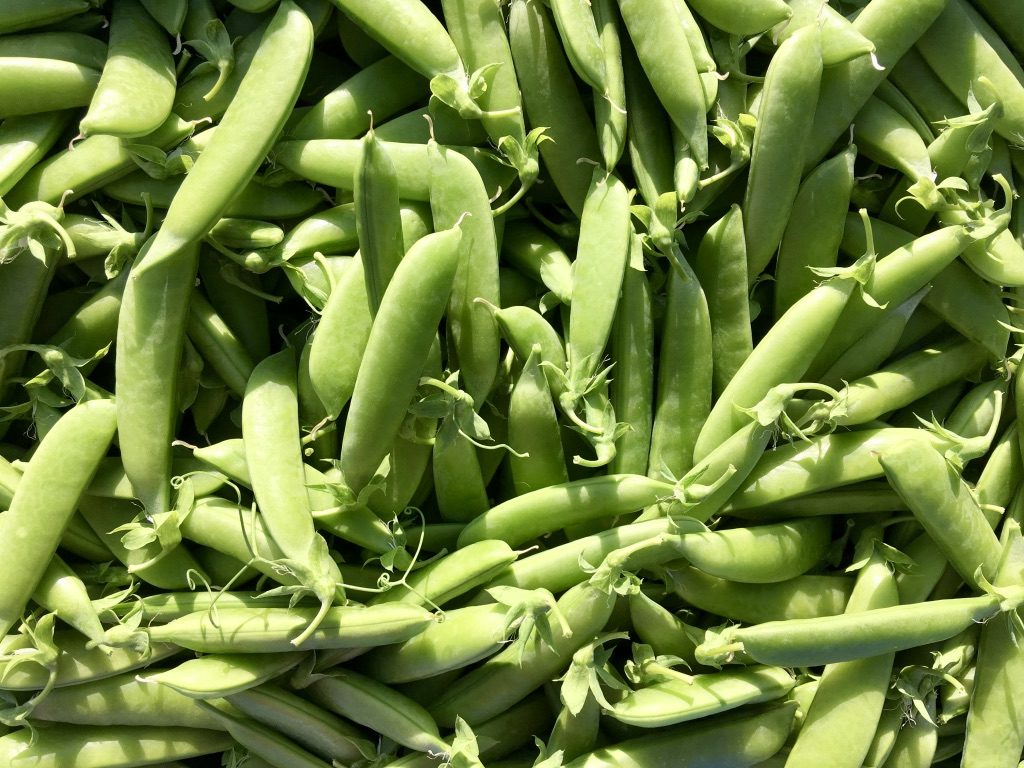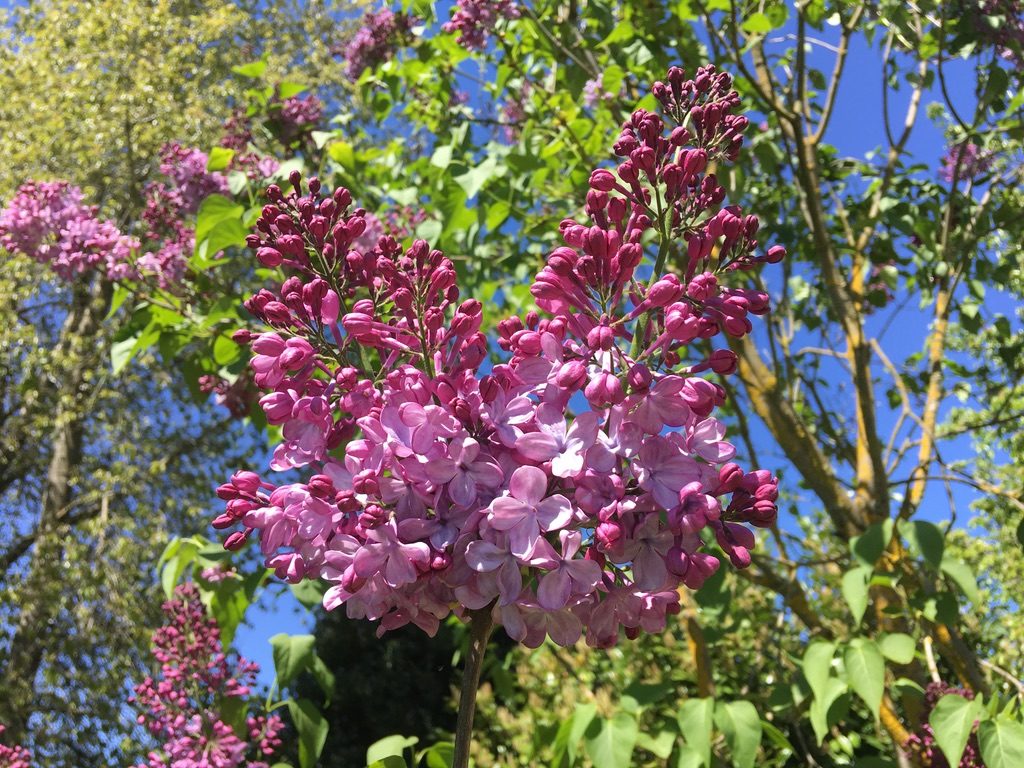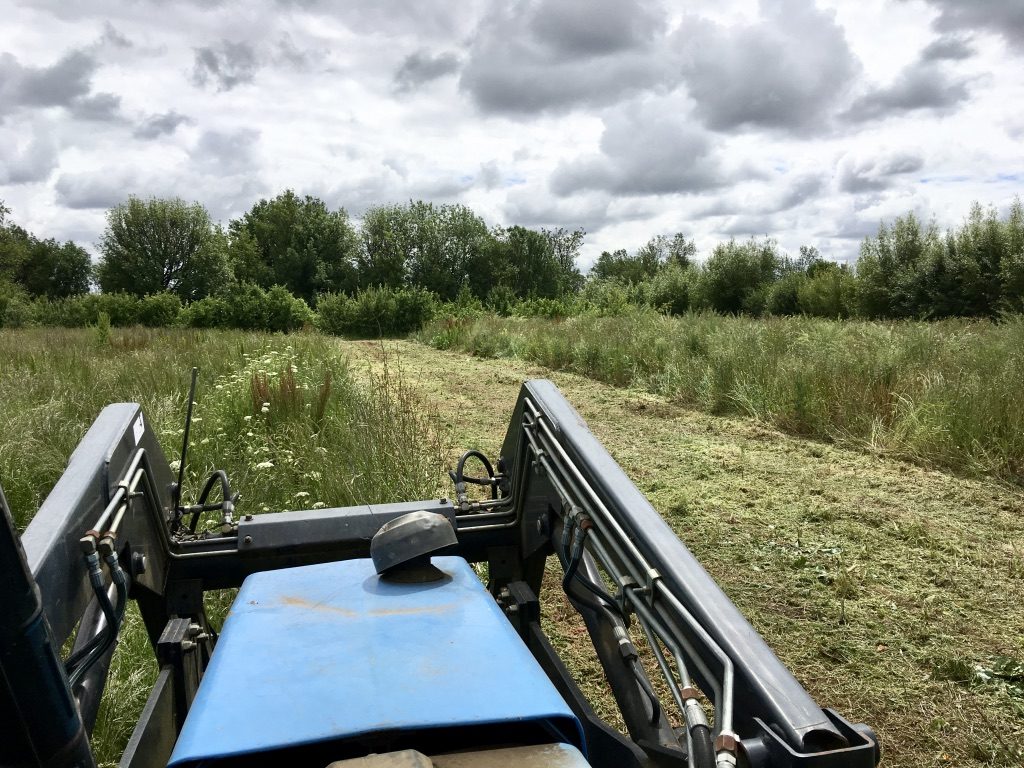
Unmowed field ahead; just mowed swath of field to the right
This weekend, I spent a solid half a day mowing the acre plot where we over-wintered vegetables from last fall to spring. This is always an essential planting for our long-season CSA, providing us cabbages and greens in the earliest days of the season. We like to milk it it as long as possible into the late spring, because spring itself can be so unpredictable! Some years bring us dry, warm springs and planting in the fields feels easy. Other years, such as this one, late snows, flooding, and cool weather, can set us back. Which is why we’re grateful to have the overlapping insurance plan of over-wintered veggies and high tunnels for early planting.
But, then there’s a time when that over-wintered stuff is very done. When we’ve long picked the last of the tender rapini and the over-wintered brassica plants are over our heads with maturing seed pods. By that point, the planting contains little that’s tender or edible but instead features lots and lots of flowering and seeding plants — again, many of them taller than us. In between all these plants grow the many weeds that have taken advantage of our attention being elsewhere (or gotten established during the months when weeding is just an impossible muddy mess). Grasses join the mix of seed heads, along with prickly lettuce and dock.
And, so, we mow! This particular late spring task is what inspired us years ago to buy what is definitely our burliest, most powerful individual farm implement: a six-foot wide flail mower. How does one take a veritable jungle and turn it back into a field (potentially one that might even be ready for working up again in the same season)? It takes a lot energy to do that — we learned early on that a “rotary cutter” (i.e. a mower with a circular moving blade horizontally above the soil surface), just leaves giant stalks on the surface of the ground, which dry out into hard woody debris that can’t biodegrade because it’s sitting outside the range of the vibrant microbial and fungal life that is in the soil. On our farm, we don’t “make” compost in piles but instead let our soil life do the work by integrating debris and cover crops into the soil itself. But, first, we have to make that possible!
Enter, the flail mower. Flail mowers employ multiple rows of knife-like teeth that spin vertically over the soil surface, chopping and mulching in one powerful pass. If you look at the photo above, taken from the tractor seat, mid-mowing, you can see the dramatic work it can do — reducing seven-foot tall mustard plants to a fine layer of “mulch” on the surface of the soil. Even this is a thick enough layer that integrating it will taking plenty of effort and time, but it is an impressive change in the state of the biomass! Chopping the matter in that way, makes it immediately more available to microorganisms, thus closer to contributing to future soil organic matter and fertility. This tool is a big part of our farm’s long-term soil management plan, as we use it on nitrogen-fixing cover cropped fields as well, allowing us to tap into the free energy of the sun to create biomass and nitrogen that we can then integrate into the soil.
And, we are so grateful for this tool and how it lets us build our farm’s fertility cycle based more on sun and seed inputs and less on off-farm inputs, such as manure or other animal by-products. We do use these kinds of organic inputs but in limited quantities, as needed. Our first choice is always to foster the natural systems and give each field lots of time to build organic matter and fertility before farming it in veggies again.
But, there’s something rather awesome and humbling about using this tool as well. When we are driving the mower through our fields, we are endowed with a profound amount of power to change our environment very quickly through an act that can feel destructive. In part of one day, I razed a dense field that was a teeming biological jungle of flowers and seeds, providing food and habitat to all kinds of small insects and animals. We always try to mow early enough in the season to avoid nests being built in the over-wintered vegetables, but it’s still clear that those plants provide plenty of shelter and food to birds anyway. As I mowed, I watched flocks of Goldfinches dancing ahead of me, feeding on the fluffy seeds from the prickly lettuce plants. Whole life cycles of plants and insects were cut short by my mowing. The act always feels necessary (so many weeds and plants going to seed!), and yet it feels like a significant thing to choose to destroy such dynamic life. We approach it with gravity and purpose, not taking our role on this farm lightly.
Homo sapiens sapiens, almost by definition, seems to be an animal with a unique urge to shape our environment. In its worst forms, this “shaping” can lead to degradation of landscapes and other populations of plants and animals. I am just finishing Andrea Wulf’s biography of Alexander Von Humboldt, The Invention of Nature, and it is fascinating to read about the work of 19th century naturalists — such Humboldt himself, Charles Darwin, George Perkins Marsh, and John Muir — who were among the first modern Europeans to recognize the interconnectivity of life on the macro and micro levels. And, then of course, to recognize the layers of long-term, deep level impacts human efforts such as industrialization, mining, and agriculture can have on landscapes. These scientists witnesses such changes first-hand during an era of increased industrialization across the globe. I can only imagine how terrifying it must have been to be among the first of their world to cry out in alarm at rapid degradation.
Casey and I are “descendants” of that era of industrialization and colonization. We live and farm land that was previously the home of the Kalapuya peoples, now a completely different landscape than the one they would have known. The Willamette Valley today is shaped by tools such as ours: powerful tractors that can till and mow. The cultivation emphasis in the valley is mostly on annual crops or short-lived perennials (with some very erosion-prone orchards in the mix too). Soil erosion is a thing in the Willamette Valley, my friends. It’s a big thing that you can see in the dust in the air in the summer and rivulets cutting through bare fields or orchards in the winter. Contemporary farmers actually have learned from those early voices about conservation, and many farmers do employ soil conservation methods today. But, the landscape is still one that is being shaped by our tools and methods, and these choices have consequences for other life and future generations.
But, contemporary farmers are not the first homo sapiens sapiens to shape this landscape. As part of our home learning life, the kids and I emphasize learning a lot about this place where we live: about the flora and fauna and the history of the people who lived here before us. From what we have read about the Kalapuya peoples, I try to imagine how our valley might have looked 300 or more years ago. They too cultivated the land for food production, but growing very different crops and using very different technologies. European settlers in North American didn’t even recognize Native American cultivation techniques because they were so radically different from the tillage methods employed in Europe (not to mention the absence of fences, private property field boundaries, and straight lines!).
Here in the Willamette Valley, the Kalapuya peoples cultivated many annual crops, such as camas and tarweed, in long-term plots that were nurtured and tended to keep them producing year after year. These crops, along with open pasture to promote wild animal populations, were maintained (and sometimes even harvested) using controlled, intentional burns. It’s my understanding that these plots were also maintained by not harvesting every singly plant, but instead leaving enough bulbs or rhizomes in the ground, essentially creating perennial patches out of plants with annual life cycles.
Reading Charles C. Mann’s book, 1491: New Revelations of the Americas Before Columbus, really helped me better understand the fundamentally different cultivation paradigms at work in a place like the Willamette Valley before European settlement here. Now, when I walk through forests and observe so-called “wild” berries such as Thimbleberries or Salmonberries, I have a better appreciation for the role humans played in maintaining these populations over countless generations of people living in the region. “Hunting and gathering” was not a lifestyle of random wandering through a “coincidentally” edible landscape, but instead an intentional fostering of edibility within a familiar landscape, through which one moved as seasonally and cyclically appropriate. I think the difference here is still hard for modern people to grasp, but it is a reality I feel like I have tiny glimpses into after living here for over a decade. As we’ve built our mental maps of where certain berries grow in the forest, or where there are patches of mushrooms in the fall, we go back again and again with a real knowledge of what we will likely find. And, we do things like leave mushrooms behind on new logs, in hope of seeding new patches. Imagine if an entire community shared a vast mental map of the edible landscape, built over generations. And if each year, intention was put into fostering more of that edible abundance. Just imagine.
I love to picture how fundamentally different this region would have looked under the management of people with very different technologies and paradigms about their relationship to the land and how to care for it. Where we now have dense, scrubby brush, I picture prairies with tall trees, intentionally fostered as a home for all kinds of life. I picture a meandering Willamette River with Wapato growing along its banks and Lamprey eels swimming along its bottoms (and so many salmon).
People lived here for thousands of years, shaping the landscape with human ingenuity, but in ways that sustained and fostered health of the entire ecosystem. This fact deeply saddens me, knowing the hard stories of how that balance came to be lost. It also, however, inspires me, giving me hope that Homo sapiens sapiens can make use of our creative energy to shape our world in ways that promote life. The knowledge exists both in ancient traditions and also in cutting-edge science, as people today work to incorporate different paradigms of sustainability into contemporary life, and specifically food production.
It feels like a tragically slow road to walk toward sustainability, especially in light of what knowledge and practices have been lost or set aside in the meantime. But I feel like it is an essential part of that journey to acknowledge our dual role as humans: both as creators and destroyers, and to acknowledge that often one leads to the other. The creation of industrialization led to destruction, but destruction can also be an integral part of creation too — such as the extensive use of fire by the Kalapuya people.
When we get on the tractor to mow with the goal of building soil and keeping our fields weed free for future crops, I hope that our actions lean more heavily toward destruction as an act of creation. That our modern methods of cultivation promote an overall increase in the dynamism of this place, which to us can be measured or observed as diversity and abundance and fecundity. (Although, as an aside, I think it’s important acknowledge that in the diversity of ecosystems around the world, there are sometimes other measures of ecosystem health.)
Our goal as food farmers is to steward the soil and water we have here, and our goal as naturalists living here is to foster the lives of other plants and animals too. We’ve planted hundreds of trees on our land and actively maintain wild buffers that can act as habitat and corridors for animals and birds. Our farm is just one small chunk of land in the larger world, but we take our responsibility here seriously. When our work here feels like it requires destruction, then we remember that this is sometimes a part of creation, but it must always be balanced with that goal. As humans, we have such power. We have flail mowers! Not to mention, tools powerful well beyond what Casey and I have at our disposal. If I could have one wish for humanity, it would be for greater awareness of how much responsibility comes with these kinds of power and these technologies. Hopefully, each generation of the modern world will move closer to finding that balance again through intention and humility and increased dedication to truly leaving every place better than when we found it.
Enjoy this week’s vegetables!
Your farmers, Katie & Casey Kulla
P.S. In related farm news, we received our certification paperwork for the Oregon Department of Agriculture this week! Folks may remember that last year, our former certifying body went out of business mid-season, leaving us in a bit of a lurch. We reapplied this year (this time with the ODA), and now we’re good to go! Oakhill Organics is certified organic! Woo hoo! I could write more about how the meaning of the certification process for us, but I think I’ve written enough words for today …
~ ~ ~
Meet this week’s vegetables:
- Apples
- Strawberries
- Sugar snap peas
- Zucchini
- Cut lettuce mix — An all-lettuce salad mix this week! We have two lettuce options for you, and you’re welcome to take both! (Some people like to eat their cut lettuce mix first and then the head lettuce later in the week, since it sometimes stores better.) With this heat, who needs to cook for dinner? Make yourself a Big Green Salad with loads of toppings and slices of bread on the side!!!!
- Head lettuce
- Kohlrabi — How does one eat this strange-looking vegetable? It’s easy! We just peel it (usually with a paring knife), and then slice it and eat it raw! It’s a great “dipping” vegetable if you have hummus or other dip around. A really easy, cool snack for a hot day.
- Broccoli
- Kale
- Chard
- Fava beans — See last week’s newsletter for a reminder on how to prepare fava beans!
